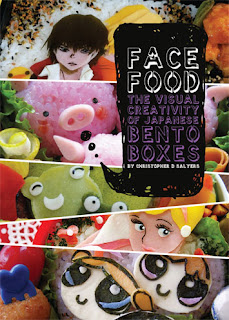Author: Christopher D Salyers
Publisher: Mark Batty Publisher
Release date: 2008 (my edition at least)
Length: 71 pages
Publisher: Mark Batty Publisher
Release date: 2008 (my edition at least)
Length: 71 pages
I bought this book when I was still fairly new to the bento scene. A summary of the book wasn't available on the site where I bought it, so I thought I had bought a book with nifty tutorials on how to make these cute charaben. Well I didn't get what I expected, that's for sure. Other then pictures of beautiful bento & a list of ingredients used, tutorials weren't to be found in this book. Heck not even recipes. I have to say that I was disappointed and the book, how pretty as the pictures were, ended up in the back of my closet.
I only got it out since I have set this goal to review on my bento blog what I already have on bento gear and this includes books. Flipping through the pages again, I saw for the first time what it really was about, since last time I didn't read the text in the book at all. Not that there is much text to read, but I did read there notes from the author this time around. It turned out that he had set out to interview people who make these charaben in Japan and I have to say that the look on bento from these people surprised me a bit. It made me realise that most of the makers don't even see it as food art at all.
Here in the Netherlands a lot of people I know see making charaben as a form of art, but to the people in Japan it is all about showing your love for your child and they stop with making charaben when their child gets too old for cute food. This is a difference since here it gets also done by adults who think it is just cute and for me personally, I even make semi cute lunches for my BF. So it was interesting to read this and I actually did learn something new about the view of Japanese people on charaben, or at least from the people who were interviewed because I am sure there are exceptions ;) Or course to me showing your affection to someone by making a bento does play a huge part as well, but I also like to make cute lunches for myself.
Some quotes from the book, to illustrate what I mean:
"The charaben helped their child become more popular at school, thus improving their social standings and subsequently their ego."
"When I asked Takupapa if he would continue to make charaben after his son lost all interest, his answer was a prompt and austere no."
"Though the may not have, as of yet, found their place as an art form, the act of charaben alone is one of intense parent-to-child devotion."
I must be honest and tell you that I didn't read all the interviews in the book. This is not because it doesn't interest me, but mainly because they are so hard to read because they used special fonts in the book that aren't easy on the eyes. I find this a real pity because the value lies in those interviews. I have to say that I am glad that I could learn what I did, however it is too limited to make the book worthwhile, since I can also look at beautiful pictures online. They seem to be the main focus of this book and the chosen fonts only illustrate this point.It is a pity really, because the author actually wanted this book to be more. To give people a peek into the Japanese bento culture, but the layout of the book, doesn't help with getting that point across.
If you want to buy this book, you can do so at amazon.
You can find other reviews: At Just bento, Adventures in Bentomaking and Fandomania.
If you have reviewed this book and want your link here, please leave a comment with the link, and I will add it here :)
You can find other reviews: At Just bento, Adventures in Bentomaking and Fandomania.
If you have reviewed this book and want your link here, please leave a comment with the link, and I will add it here :)


If you want, I have a review of both here: http://www.aibento.net/2009/12/09/review-face-food-recipes/
ReplyDeleteI too was disappointed they were both just coffee table books. :(
Thank you for your comment :) I have added your link :)
ReplyDeleteSuch a pity this book wasn't what you expected, but it's a good thing you picked it up a second time and found something interesting in it.
ReplyDeleteI think people in the Netherlands (and elsewhere) probably make their bentos much more beautiful than the average Japanese(without kids). Isn't that funny?
@leeswammes: I don't know about that. However there is a point that people outside Japan who are into bento, are so because they choose to do so (for various reasons) and not because it is a part of their upbringing. I think that is the key difference :)
ReplyDelete